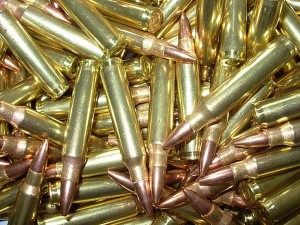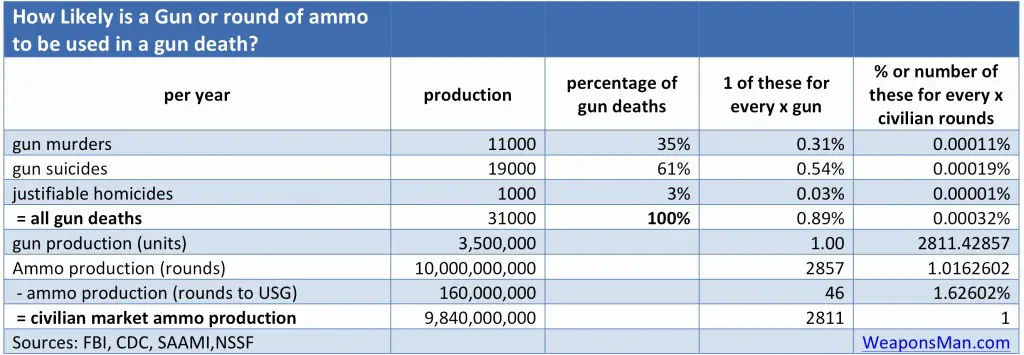 We wrote in one of our “when guns are outlawed” posts:
We wrote in one of our “when guns are outlawed” posts:
Here is a thought about guns. About 3.5 million guns are manufactured every year, and about 10 billion rounds of fixed small arms ammunition. The anti-gunners say 30,000 “gun deaths” occur annually (a figure they get to by lumping murders, justifiable homicides by police, ditto by citizens, and suicides — which alone are two thirds of “gun deaths” — into a single number). So less than 1% of one year’s production of guns is used in a “gun death”, and about 3 one-hundred-thousandths of a percent of one year’s civilian ammo production is used in a “gun death.” Change the denominator to homicides, and even using CDC’s padded number, the percentages drop to 0.31% and a vanishingly small 0.00011% — eleven hundred-thousandths of a percent. We’ll elaborate on this in a post in the next few days.
Herewith the promised elaboration.
There are few credible sources of gun crime data, and fewer still of production numbers; companies consider the latter to be proprietary information and the numbers they furnish to government agencies may not be complete or comprehensive. For example, Pitman-Robertson Act excise taxes are on value, not units, and encompass many non-firearms goods which are sometimes made by the same companies that make guns, so P-R tax information is worthless to us.
As an aside, some people have expressed concerns about Government purchases of small arms ammunition distorting the market. The statistics suggest that this is not happening. While total production figures vary from SAAMI and NSSF, and can only be considered estimates, Government purchases are made under public contracts. The 10-billion-round figure comes from press releases and media quotes from those sporting-and-self-defense-arms trade groups, and seems to be their go-to number in 2013.
 The US Government (mostly DOD but also civilian agencies) does buy a lot of small arms ammunition: about 160 million rounds a year. But that’s a drop in the 10-billion-round bucket. That means civilian, general public ammo purchases are about 9.84 billion. That number can always be rounded off — to 10 billion.
The US Government (mostly DOD but also civilian agencies) does buy a lot of small arms ammunition: about 160 million rounds a year. But that’s a drop in the 10-billion-round bucket. That means civilian, general public ammo purchases are about 9.84 billion. That number can always be rounded off — to 10 billion.
The Government statistics for gun homicides between the FBI and the CDC don’t agree. This may be due to different methods and purposes of data collection. The Bureau collects statistics from state and local jurisdictions for law enforcement purposes and publishes them (with many warnings about how to use and not to use them), but the CDC collects statistics primarily from medical epidemiological surveillance nets, for purposes of promoting gun control proposals. The FBi slices and dices their data several ways, the CDC obscures its sources and seems to inflate its firearms-related data.
There are about 13,000 unlawful homicides a year. Of these about half are with handguns and another rough 800 with other known firearms, and nearly 2,000 with unspecified firearms (which are probably handguns, but proof is absent). In all there are about 9,000 gun murders a year. There are, in addition, less than a thousand justifiable homicides (some 400 by police and 250-300 by citizens annually). CDC reports nearly 40,000 total suicides and 120,000 accidents for their most recent data set, 2010. CDC claims that 19,000 of the suicides and 11,000 homicides (CDC admits no difference between murders and justifiable homicide) were by firearm in 2010, their latest data. CDC also apparently blends firearms accidents into their homicide total; that and the justifiables might tend to explain why their data is higher than the FBI’s.
(This is where anti-gun groups get their number of “30,000 gun deaths,” plumping up the murder stats with accidental shootings and justifiable shootings by police and private citizens. In some jurisdictions, justifiable shootings amount to half or more of homicide totals).
Even taking the antis’ and the CDC’s dodgier statistics, and assuming that one gun and one cartridge was used per homicide, the numbers are vanishingly small.
These tiny numbers are also inflated at least two other ways. The fraction or percentage we’re interested is Guns used in Killings divided by Guns in Circulation. First, this table overstates Guns used in Killings because it assumes 1 gun per 1 crime. Criminals often use one gun to commit multiple crimes. (Occasionally more than one gun is used in a single homicide, but that is very rare; whereas, consider the murder-suicide event, a depressingly common eventuality that usually yields two or more deaths from one gun). Therefore, the numerator of our fraction is seriously overstated. Conversely, we do not use Guns in Circulation here, but Annual Gun Production, which is a very poor proxy: guns are among the most durable goods extant, with a useful life of centuries; every year 3.5 million new ones are made, and perhaps a couple of hundred thousand destroyed. Credible estimates of guns in US circulation are in the 300 million range, but using that as the denominator of our fraction would have yielded numbers so small they would have to be expressed in scientific notation. Therefore, the denominator of our fraction is even more seriously understated.
Therefore, it follows that the very small numbers in the table, to the extent that they are inaccurate, are almost certainly inaccurate on the high side. We consider them a very generous upper bound to the likely real number of guns and ammunition used in homicide. We also believe that every attempt has been made to us the gun control establishment’s own data, however questionable, and the data most favorable to their argument. This should give you some idea of how weak their data actually are, and some understanding of why they prefer emotionally-based to factually-based argumentation.
One is reminded of the old lawyers’ aphorism: “If the law is on your side, pound on the law; if the facts are on your side, pound on the facts; if neither the law nor the facts are on the side, pound on the table.” The only thing that is missing to be a description of anti-gun messaging is the necessary coda: “For The Children™.”

Kevin was a former Special Forces weapons man (MOS 18B, before the 18 series, 11B with Skill Qualification Indicator of S). His focus was on weapons: their history, effects and employment. He started WeaponsMan.com in 2011 and operated it until he passed away in 2017. His work is being preserved here at the request of his family.


3 thoughts on “What percentage of guns and ammo are used in murder?”
“CDC reports nearly 40,000 total suicides and 120,000 accidents for their most recent data set, 2010. ”
The number is the total for all accidents annually, firearms usually only contributing on the order of 0.5% (typically ranking 15th out of 20 “leading” accidental causes per annum, beating out only things like bicycles, snakebite, and lightning strikes) of that total, usually around 600 annually. And looking at the numbers broken down by age, gun accidents for those under the age of 14 (which helpfully disincludes stats from Julio or Cletus in their budding careers with MS-13 or the Crips) amounts annually to about 60, or roughly one child, per state, per year.
For a statistical number of 0.000002 or 0.0002% of all deaths.
Versus, for instance, falls, which kill >54,000 people annually, or more than all gun deaths combined.
So what they should be doing is trying to ban gravity, if saving lives was the actual underlying purpose.
What’s really cool is in the 3 years and 9 months from Pearl Harbor to V-J day the US government’s Industry-Ordnance team supplied 47 billion rounds for small arms to American Soldiers and American allies.
American civilians buy enough small arms ammo to fight WWII every 5 or so years.
Source: http://www.nraila.org/news-issues/articles/2003/the-great-arsenal-of-democracy.aspx?s=ordnance%20team&st=&ps
This was an enjoyable read. I don’t know that we change the minds of anti-gunners with small numbers, but we might move the undecideds in the middle. Please keep writing and I’ll keep reading.